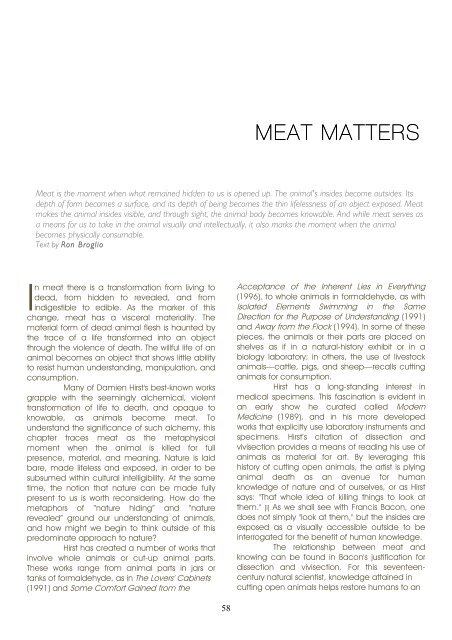Meet Animal Meat - Antennae The Journal of Nature in Visual Culture
Meet Animal Meat - Antennae The Journal of Nature in Visual Culture
Meet Animal Meat - Antennae The Journal of Nature in Visual Culture
You also want an ePaper? Increase the reach of your titles
YUMPU automatically turns print PDFs into web optimized ePapers that Google loves.
In meat there is a transformation from liv<strong>in</strong>g to<br />
dead, from hidden to revealed, and from<br />
<strong>in</strong>digestible to edible. As the marker <strong>of</strong> this<br />
change, meat has a visceral materiality. <strong>The</strong><br />
material form <strong>of</strong> dead animal flesh is haunted by<br />
the trace <strong>of</strong> a life transformed <strong>in</strong>to an object<br />
through the violence <strong>of</strong> death. <strong>The</strong> willful life <strong>of</strong> an<br />
animal becomes an object that shows little ability<br />
to resist human understand<strong>in</strong>g, manipulation, and<br />
consumption.<br />
Many <strong>of</strong> Damien Hirst's best-known works<br />
grapple with the seem<strong>in</strong>gly alchemical, violent<br />
transformation <strong>of</strong> life to death, and opaque to<br />
knowable, as animals become meat. To<br />
understand the significance <strong>of</strong> such alchemy, this<br />
chapter traces meat as the metaphysical<br />
moment when the animal is killed for full<br />
presence, material, and mean<strong>in</strong>g. <strong>Nature</strong> is laid<br />
bare, made lifeless and exposed, <strong>in</strong> order to be<br />
subsumed with<strong>in</strong> cultural <strong>in</strong>telligibility. At the same<br />
time, the notion that nature can be made fully<br />
present to us is worth reconsider<strong>in</strong>g. How do the<br />
metaphors <strong>of</strong> “nature hid<strong>in</strong>g” and “nature<br />
revealed” ground our understand<strong>in</strong>g <strong>of</strong> animals,<br />
and how might we beg<strong>in</strong> to th<strong>in</strong>k outside <strong>of</strong> this<br />
predom<strong>in</strong>ate approach to nature?<br />
Hirst has created a number <strong>of</strong> works that<br />
<strong>in</strong>volve whole animals or cut-up animal parts.<br />
<strong>The</strong>se works range from animal parts <strong>in</strong> jars or<br />
tanks <strong>of</strong> formaldehyde, as <strong>in</strong> <strong>The</strong> Lovers' Cab<strong>in</strong>ets<br />
(1991) and Some Comfort Ga<strong>in</strong>ed from the<br />
58<br />
MEAT MATTERS<br />
<strong>Meat</strong> is the moment when what rema<strong>in</strong>ed hidden to us is opened up. <strong>The</strong> animal's <strong>in</strong>sides become outsides. Its<br />
depth <strong>of</strong> form becomes a surface, and its depth <strong>of</strong> be<strong>in</strong>g becomes the th<strong>in</strong> lifelessness <strong>of</strong> an object exposed. <strong>Meat</strong><br />
makes the animal <strong>in</strong>sides visible, and through sight, the animal body becomes knowable. And while meat serves as<br />
a means for us to take <strong>in</strong> the animal visually and <strong>in</strong>tellectually, it also marks the moment when the animal<br />
becomes physically consumable.<br />
Text by Ron Broglio<br />
Acceptance <strong>of</strong> the Inherent Lies <strong>in</strong> Everyth<strong>in</strong>g<br />
(1996), to whole animals <strong>in</strong> formaldehyde, as with<br />
Isolated Elements Swimm<strong>in</strong>g <strong>in</strong> the Same<br />
Direction for the Purpose <strong>of</strong> Understand<strong>in</strong>g (1991)<br />
and Away from the Flock (1994). In some <strong>of</strong> these<br />
pieces, the animals or their parts are placed on<br />
shelves as if <strong>in</strong> a natural-history exhibit or <strong>in</strong> a<br />
biology laboratory; <strong>in</strong> others, the use <strong>of</strong> livestock<br />
animals—cattle, pigs, and sheep—recalls cutt<strong>in</strong>g<br />
animals for consumption.<br />
Hirst has a long-stand<strong>in</strong>g <strong>in</strong>terest <strong>in</strong><br />
medical specimens. This fasc<strong>in</strong>ation is evident <strong>in</strong><br />
an early show he curated called Modern<br />
Medic<strong>in</strong>e (1989), and <strong>in</strong> his more developed<br />
works that explicitly use laboratory <strong>in</strong>struments and<br />
specimens. Hirst’s citation <strong>of</strong> dissection and<br />
vivisection provides a means <strong>of</strong> read<strong>in</strong>g his use <strong>of</strong><br />
animals as material for art. By leverag<strong>in</strong>g this<br />
history <strong>of</strong> cutt<strong>in</strong>g open animals, the artist is ply<strong>in</strong>g<br />
animal death as an avenue for human<br />
knowledge <strong>of</strong> nature and <strong>of</strong> ourselves, or as Hirst<br />
says: "That whole idea <strong>of</strong> kill<strong>in</strong>g th<strong>in</strong>gs to look at<br />
them." [i] As we shall see with Francis Bacon, one<br />
does not simply "look at them," but the <strong>in</strong>sides are<br />
exposed as a visually accessible outside to be<br />
<strong>in</strong>terrogated for the benefit <strong>of</strong> human knowledge.<br />
<strong>The</strong> relationship between meat and<br />
know<strong>in</strong>g can be found <strong>in</strong> Bacon's justification for<br />
dissection and vivisection. For this seventeencentury<br />
natural scientist, knowledge atta<strong>in</strong>ed <strong>in</strong><br />
cutt<strong>in</strong>g open animals helps restore humans to an












